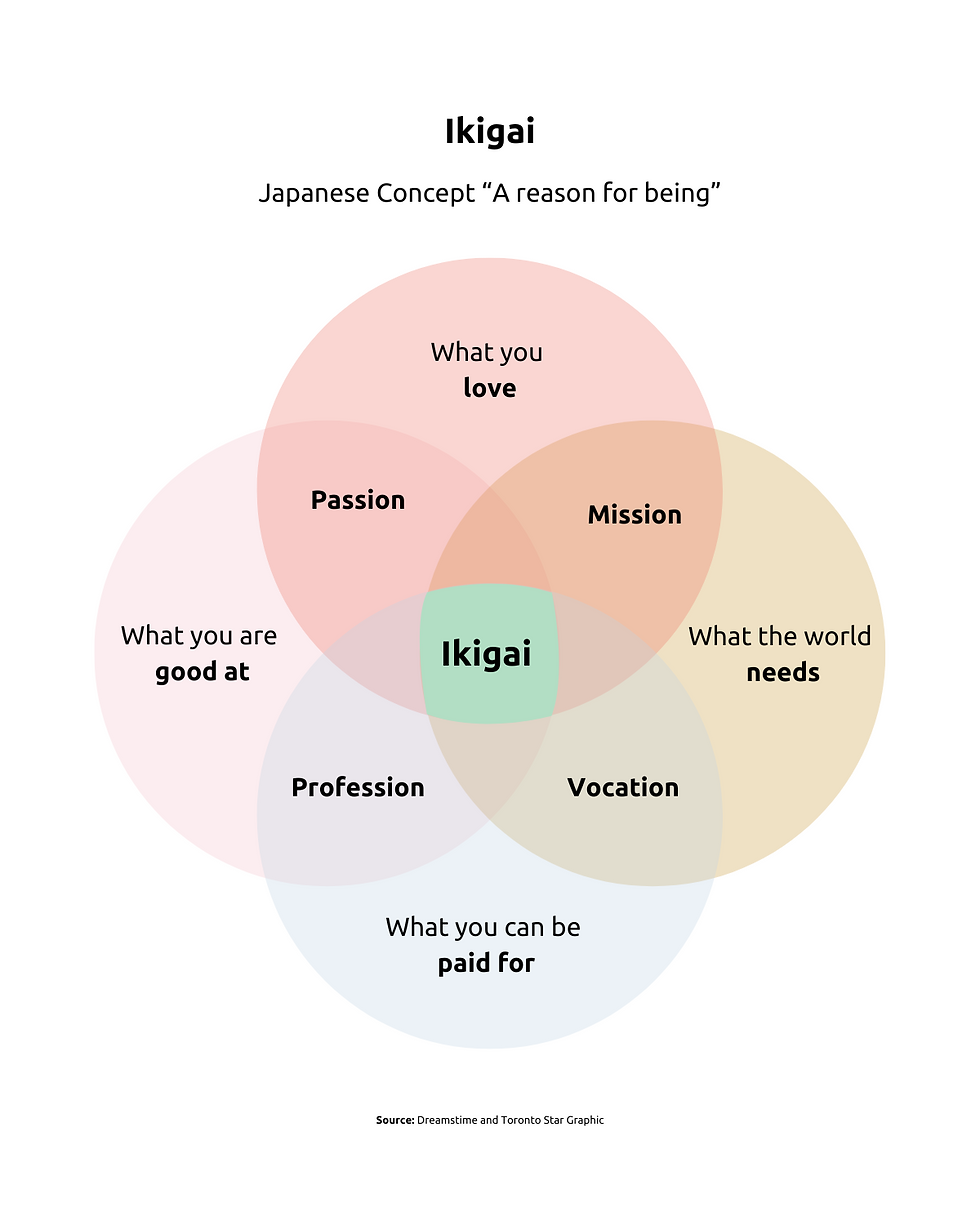Find Your Ikigai & Align It With Your Strengths
- Anton Rademan
- Mar 4, 2025
- 6 min read
Discover What Truly Drives You & Take Action
Have you ever felt stuck in your career, unsure if you're on the right path? You're not alone. Many people search for work that feels meaningful—but the answer isn’t just another job; it’s about aligning your life with your purpose. That’s where Ikigai and Strengths Alignment come in.
Ikigai (pronounced ee-key-guy) is a Japanese concept that means 'reason for being.' It’s where what you love, what you’re good at, what the world needs, and what you can be paid for all intersect. When you align your life and career with your Ikigai, work stops feeling like a struggle—it becomes something that energizes you.

Similarly, VIA Character Strengths help you understand your core qualities and strengths—the natural traits that define how you think, feel, and behave. The VIA Strengths Assessment identifies your top character strengths, which reflect your values and motivations. When your work aligns with these strengths, you experience more fulfillment and engagement in your daily life.
In this blog, we’ll guide you through a step-by-step process to find your Ikigai, compare it with your VIA Character Strengths, and gain deeper insights using our AI Coaching Assistant.
Step 1: Understanding the Ikigai Framework
Ikigai is found at the intersection of four core areas:
What You Love – Your passions, interests, and things that excite you.
What You Are Good At – Your natural talents and skills.
What The World Needs – Areas where your skills and interests can make an impact.
What You Can Be Paid For – Work that provides financial sustainability.
When these areas overlap, you find your Ikigai, where your work aligns with your purpose.
Step 2: Identify Your Ikigai
Take a moment to reflect and answer these questions:
What You Love
What activities make you feel truly alive and fulfilled?
What do you enjoy doing even if no one pays you for it?
What topics or causes are you naturally drawn to?
What You Are Good At
What skills or talents come easily to you?
What do others often ask for your help with?
What achievements are you most proud of?
What The World Needs
What problems do you see that you wish you could help solve?
What kind of change do you want to create in the world?
What do people often thank you for?
What You Can Be Paid For
What skills, services, or expertise do people pay for?
What career paths or business opportunities align with your strengths?
How can you connect your passions with financial sustainability?
Write down your answers and look for patterns—these are clues to your Ikigai.
Tips:
Don't try to make it perfect. Write down as many things as possible before looking for patterns.
Ikigai evolves as we do. Even if you have done it before, do it again to see how it has shifted over time.
Now, choose one key element from each category that resonates most with you. These will help define your Mission, Vocation, Profession, and Passion in the next step.
Step 3: Define Your Mission, Vocation, Profession, and Passion
Now that you have chosen one key element from each category, let’s organize them into the Ikigai framework:
Mission (What You Love + What the World Needs)
Ask yourself: How can I use what I love to contribute to the world?
Example: If you love helping people solve problems and the world needs better mental health support, your mission could involve coaching, counseling, or community outreach.
Vocation (What the World Needs + What You Can Be Paid For)
Ask yourself: How can I serve a need in the world while earning a living?
Example: If the world needs stronger leadership in businesses and you can be paid for training programs, your vocation might be executive coaching or leadership consulting.
Profession (What You Are Good At + What You Can Be Paid For)
Ask yourself: How can I turn my skills into a career?
Example: If you are good at strategic thinking and people pay for business consulting, your profession could be management consulting or strategic advising.
Passion (What You Love + What You Are Good At)
Ask yourself: What excites me that I also have natural talent in?
Example: If you love storytelling and are good at writing, your passion might be creating impactful content, blogging, or marketing storytelling.
By placing your chosen elements in these four categories, you gain clarity on where your current strengths and interests lie.
Bridging the Gaps
Once you have defined your Mission, Vocation, Profession, and Passion, reflect on any gaps:
Are you spending too much time in one area while neglecting others?
Is there alignment between what you love and what you do for work?
How can you incorporate missing elements into your career or lifestyle?
Step 4: Find Your Purpose (Ikigai)
Once you've mapped out your Mission, Vocation, Profession, and Passion, take a step back and reflect:
Do these elements fit together naturally?
Are there areas where you feel unfulfilled?
How can you integrate these elements into your current career or explore new opportunities?
Your Ikigai emerges when all four areas are in harmony. It may take time and experimentation, but the key is to take small steps toward greater alignment.
Step 5: Compare With Your VIA Character Strengths
Once you have a clearer picture of your Ikigai, the next step is to compare it with your VIA Character Strengths. If you haven’t done your VIA Strengths Assessment, you can complete it here for free.
The VIA Strengths assessment identifies your top character strengths, which represent the qualities that define you and how you naturally operate in the world. Comparing them with your Ikigai can help you see where you’re aligned and where gaps exist.
Reflection Questions:
How do my VIA Strengths support my Ikigai?
Are there any strengths I’m not using in my work or daily life?
Where do I feel a disconnect between my strengths and what I’m currently doing?
Example: If your top VIA strengths are Creativity, Curiosity, and Love of Learning, but you’re in a role that feels repetitive and uninspiring, there may be a gap between your strengths and your Ikigai. Recognizing this can help you explore new opportunities that align better with your values.
Step 6: Gain Insights From The AI Coaching Assistant
Once you've identified your Ikigai and reflected on your strengths, the next step is taking action. Sometimes, we need external guidance to clarify our next steps—that’s where our AI Coaching Assistant comes in.
How it works:
Engage in a conversation with the AI Coach about topics such as career transitions, personal growth, leadership challenges, building confidence, overcoming obstacles, and making meaningful life changes.
Gain insights through structured coaching questions designed to help you explore possibilities and take intentional action.
Identify practical steps to align your career and personal life with what truly matters to you.
Try it out here for free this month: AI Coaching Assistant – Start Now
Step 7: Take Action & Align Your Life With Purpose
Ikigai isn’t about finding the 'perfect' job—it’s about aligning your life and work with what brings you joy and fulfillment. Even small changes—like taking on a new project, learning a skill, or shifting how you approach your work—can bring you closer to your purpose.
Personal Story:
A client wanted to work on innovative ideas and create a meaningful impact, but they found themselves in a task-focused role that didn’t require out-of-the-box thinking. Their job was heavily structured, focused more on maximizing profit rather than helping people or driving change. They felt stagnant and unfulfilled.
Through this Ikigai process and the VIA Strengths Assessment, they realized their strengths lay in Creativity, Curiosity, and Leadership. By using the AI Coaching Assistant, they identified steps to:
Introduce innovation projects into their current role.
Network with like-minded professionals to explore opportunities.
Build a side project that aligned with their mission.
Eventually, they transitioned into a role that better fit their Ikigai, allowing them to work on innovation and impact-driven solutions while still sustaining a career.
Final Reflection:
What’s one small action you can take this week to move closer to your Ikigai?
How can you use your strengths to create more fulfillment in your daily life?
Who in your network can support you on this journey?
Remember: Your Ikigai is unique to you. The more you explore, reflect, and take action, the closer you’ll get to living with greater intention and purpose.
If you found this helpful, share it with someone who might need clarity too!
Sources
Ikigai Concept: Traditional Japanese philosophy on finding purpose and meaning in life.
Ikigai Diagram: Adapted from the widely shared concept, often credited to Dreamstime and Toronto Star Graphic.
Modern Adaptation: Popularized by Marc Winn (2014), influenced by Andrés Zuzunaga’s 2011 framework on purpose and meaning.
Further Reading:
Ikigai: The Japanese Secret to a Long and Happy Life by Héctor García & Francesc Miralles (2016)
The Little Book of Ikigai by Ken Mogi (2017)



Comments